Case Study Analysis of Mrs. Sharon McKenzie
VerifiedAdded on 2023/04/08
|13
|2863
|62
AI Summary
This case study analysis focuses on Mrs. Sharon McKenzie, a patient with congestive heart failure. It discusses the causes, symptoms, and risk factors associated with CHF. The document also provides information on the pharmacodynamics and pharmacokinetics of loop diuretics, a class of drugs used to treat CHF. Additionally, it outlines nursing care goals and interventions for managing the condition.
Contribute Materials
Your contribution can guide someone’s learning journey. Share your
documents today.
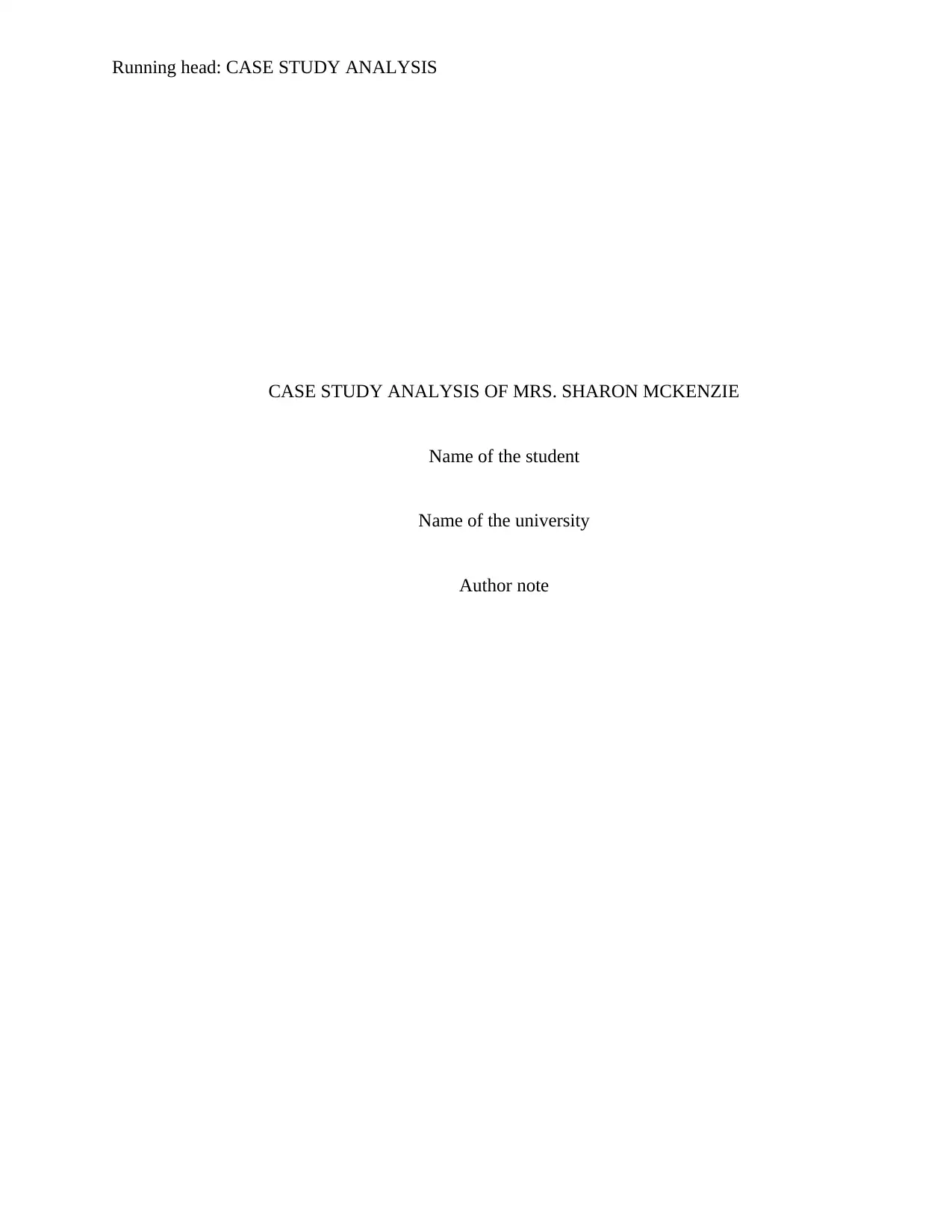
Running head: CASE STUDY ANALYSIS
CASE STUDY ANALYSIS OF MRS. SHARON MCKENZIE
Name of the student
Name of the university
Author note
CASE STUDY ANALYSIS OF MRS. SHARON MCKENZIE
Name of the student
Name of the university
Author note
Secure Best Marks with AI Grader
Need help grading? Try our AI Grader for instant feedback on your assignments.
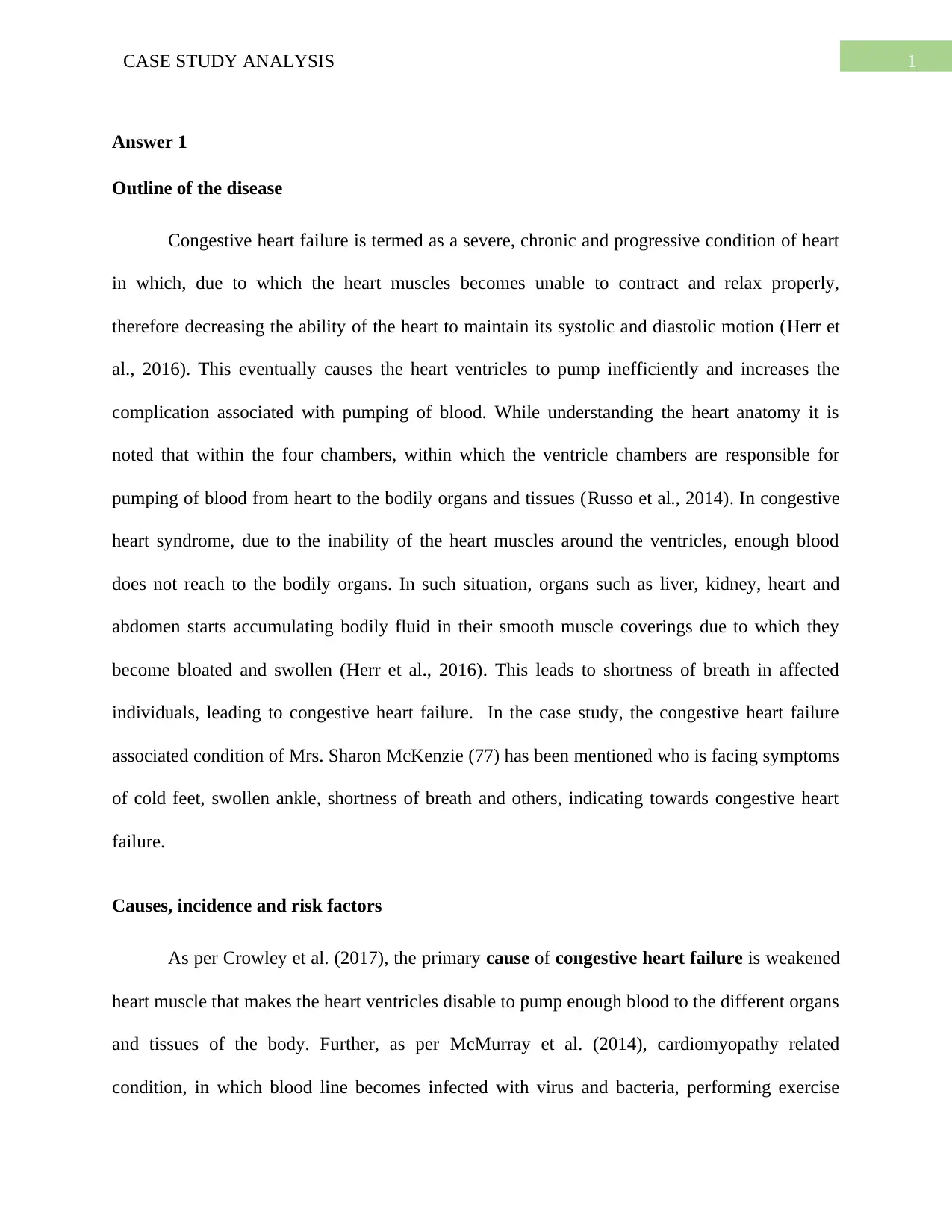
1CASE STUDY ANALYSIS
Answer 1
Outline of the disease
Congestive heart failure is termed as a severe, chronic and progressive condition of heart
in which, due to which the heart muscles becomes unable to contract and relax properly,
therefore decreasing the ability of the heart to maintain its systolic and diastolic motion (Herr et
al., 2016). This eventually causes the heart ventricles to pump inefficiently and increases the
complication associated with pumping of blood. While understanding the heart anatomy it is
noted that within the four chambers, within which the ventricle chambers are responsible for
pumping of blood from heart to the bodily organs and tissues (Russo et al., 2014). In congestive
heart syndrome, due to the inability of the heart muscles around the ventricles, enough blood
does not reach to the bodily organs. In such situation, organs such as liver, kidney, heart and
abdomen starts accumulating bodily fluid in their smooth muscle coverings due to which they
become bloated and swollen (Herr et al., 2016). This leads to shortness of breath in affected
individuals, leading to congestive heart failure. In the case study, the congestive heart failure
associated condition of Mrs. Sharon McKenzie (77) has been mentioned who is facing symptoms
of cold feet, swollen ankle, shortness of breath and others, indicating towards congestive heart
failure.
Causes, incidence and risk factors
As per Crowley et al. (2017), the primary cause of congestive heart failure is weakened
heart muscle that makes the heart ventricles disable to pump enough blood to the different organs
and tissues of the body. Further, as per McMurray et al. (2014), cardiomyopathy related
condition, in which blood line becomes infected with virus and bacteria, performing exercise
Answer 1
Outline of the disease
Congestive heart failure is termed as a severe, chronic and progressive condition of heart
in which, due to which the heart muscles becomes unable to contract and relax properly,
therefore decreasing the ability of the heart to maintain its systolic and diastolic motion (Herr et
al., 2016). This eventually causes the heart ventricles to pump inefficiently and increases the
complication associated with pumping of blood. While understanding the heart anatomy it is
noted that within the four chambers, within which the ventricle chambers are responsible for
pumping of blood from heart to the bodily organs and tissues (Russo et al., 2014). In congestive
heart syndrome, due to the inability of the heart muscles around the ventricles, enough blood
does not reach to the bodily organs. In such situation, organs such as liver, kidney, heart and
abdomen starts accumulating bodily fluid in their smooth muscle coverings due to which they
become bloated and swollen (Herr et al., 2016). This leads to shortness of breath in affected
individuals, leading to congestive heart failure. In the case study, the congestive heart failure
associated condition of Mrs. Sharon McKenzie (77) has been mentioned who is facing symptoms
of cold feet, swollen ankle, shortness of breath and others, indicating towards congestive heart
failure.
Causes, incidence and risk factors
As per Crowley et al. (2017), the primary cause of congestive heart failure is weakened
heart muscle that makes the heart ventricles disable to pump enough blood to the different organs
and tissues of the body. Further, as per McMurray et al. (2014), cardiomyopathy related
condition, in which blood line becomes infected with virus and bacteria, performing exercise
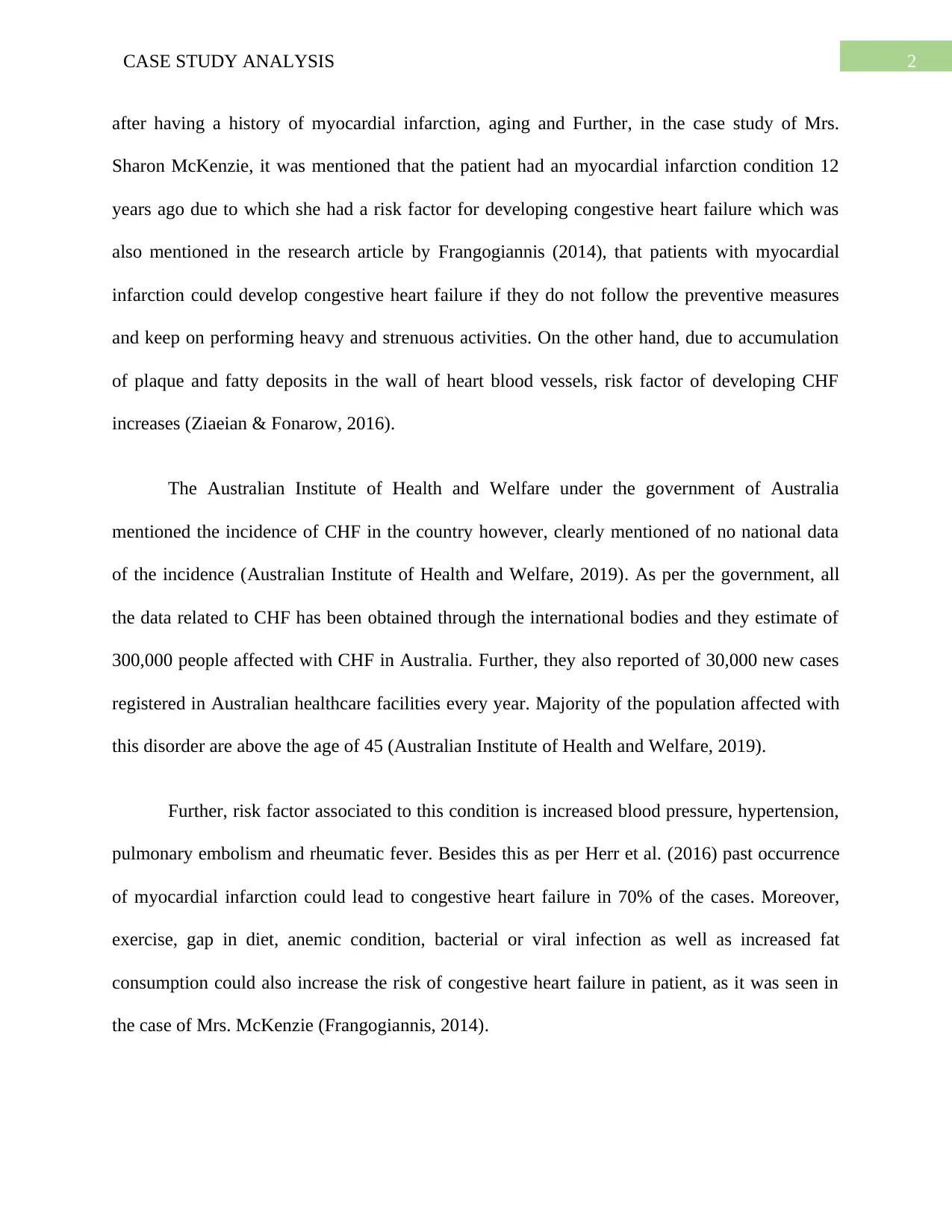
2CASE STUDY ANALYSIS
after having a history of myocardial infarction, aging and Further, in the case study of Mrs.
Sharon McKenzie, it was mentioned that the patient had an myocardial infarction condition 12
years ago due to which she had a risk factor for developing congestive heart failure which was
also mentioned in the research article by Frangogiannis (2014), that patients with myocardial
infarction could develop congestive heart failure if they do not follow the preventive measures
and keep on performing heavy and strenuous activities. On the other hand, due to accumulation
of plaque and fatty deposits in the wall of heart blood vessels, risk factor of developing CHF
increases (Ziaeian & Fonarow, 2016).
The Australian Institute of Health and Welfare under the government of Australia
mentioned the incidence of CHF in the country however, clearly mentioned of no national data
of the incidence (Australian Institute of Health and Welfare, 2019). As per the government, all
the data related to CHF has been obtained through the international bodies and they estimate of
300,000 people affected with CHF in Australia. Further, they also reported of 30,000 new cases
registered in Australian healthcare facilities every year. Majority of the population affected with
this disorder are above the age of 45 (Australian Institute of Health and Welfare, 2019).
Further, risk factor associated to this condition is increased blood pressure, hypertension,
pulmonary embolism and rheumatic fever. Besides this as per Herr et al. (2016) past occurrence
of myocardial infarction could lead to congestive heart failure in 70% of the cases. Moreover,
exercise, gap in diet, anemic condition, bacterial or viral infection as well as increased fat
consumption could also increase the risk of congestive heart failure in patient, as it was seen in
the case of Mrs. McKenzie (Frangogiannis, 2014).
after having a history of myocardial infarction, aging and Further, in the case study of Mrs.
Sharon McKenzie, it was mentioned that the patient had an myocardial infarction condition 12
years ago due to which she had a risk factor for developing congestive heart failure which was
also mentioned in the research article by Frangogiannis (2014), that patients with myocardial
infarction could develop congestive heart failure if they do not follow the preventive measures
and keep on performing heavy and strenuous activities. On the other hand, due to accumulation
of plaque and fatty deposits in the wall of heart blood vessels, risk factor of developing CHF
increases (Ziaeian & Fonarow, 2016).
The Australian Institute of Health and Welfare under the government of Australia
mentioned the incidence of CHF in the country however, clearly mentioned of no national data
of the incidence (Australian Institute of Health and Welfare, 2019). As per the government, all
the data related to CHF has been obtained through the international bodies and they estimate of
300,000 people affected with CHF in Australia. Further, they also reported of 30,000 new cases
registered in Australian healthcare facilities every year. Majority of the population affected with
this disorder are above the age of 45 (Australian Institute of Health and Welfare, 2019).
Further, risk factor associated to this condition is increased blood pressure, hypertension,
pulmonary embolism and rheumatic fever. Besides this as per Herr et al. (2016) past occurrence
of myocardial infarction could lead to congestive heart failure in 70% of the cases. Moreover,
exercise, gap in diet, anemic condition, bacterial or viral infection as well as increased fat
consumption could also increase the risk of congestive heart failure in patient, as it was seen in
the case of Mrs. McKenzie (Frangogiannis, 2014).
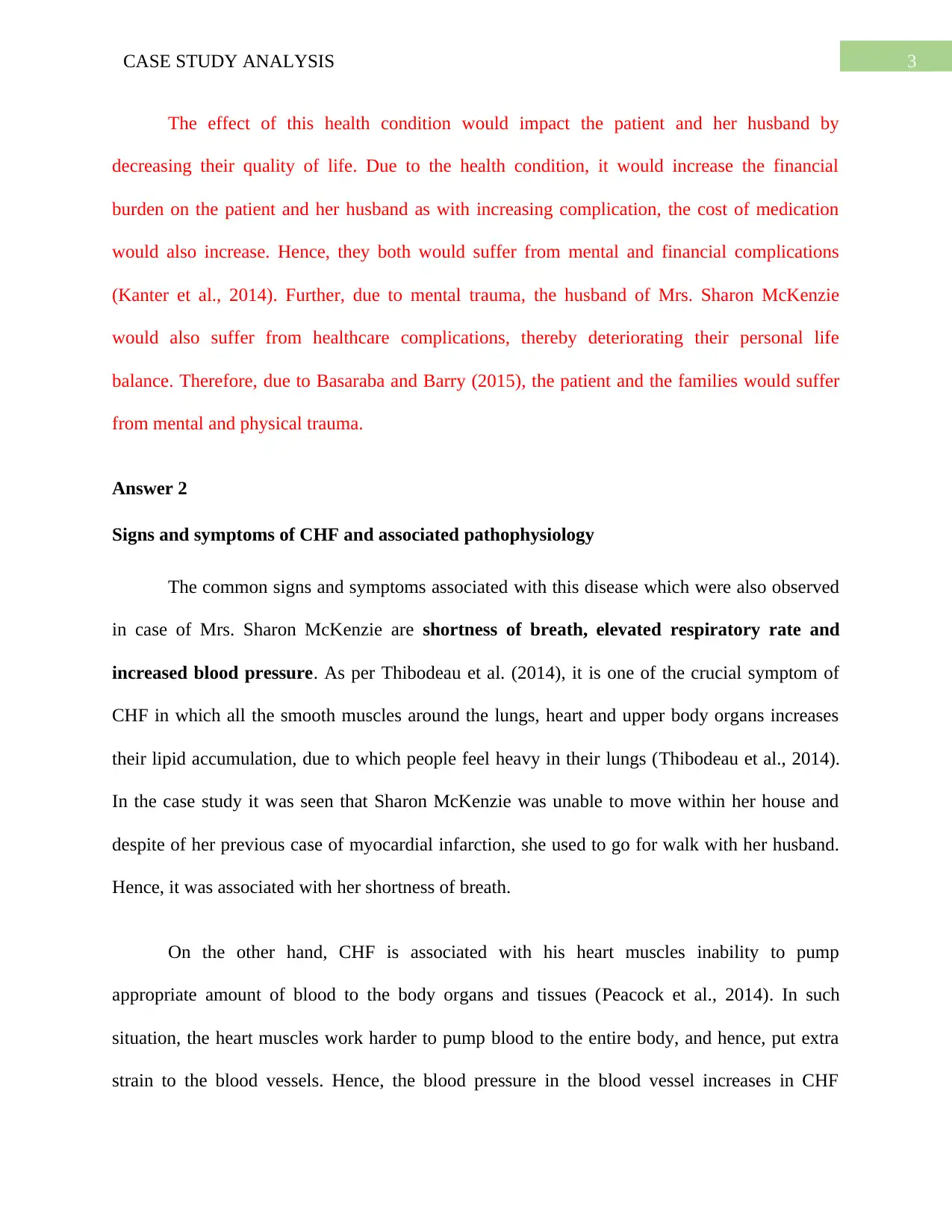
3CASE STUDY ANALYSIS
The effect of this health condition would impact the patient and her husband by
decreasing their quality of life. Due to the health condition, it would increase the financial
burden on the patient and her husband as with increasing complication, the cost of medication
would also increase. Hence, they both would suffer from mental and financial complications
(Kanter et al., 2014). Further, due to mental trauma, the husband of Mrs. Sharon McKenzie
would also suffer from healthcare complications, thereby deteriorating their personal life
balance. Therefore, due to Basaraba and Barry (2015), the patient and the families would suffer
from mental and physical trauma.
Answer 2
Signs and symptoms of CHF and associated pathophysiology
The common signs and symptoms associated with this disease which were also observed
in case of Mrs. Sharon McKenzie are shortness of breath, elevated respiratory rate and
increased blood pressure. As per Thibodeau et al. (2014), it is one of the crucial symptom of
CHF in which all the smooth muscles around the lungs, heart and upper body organs increases
their lipid accumulation, due to which people feel heavy in their lungs (Thibodeau et al., 2014).
In the case study it was seen that Sharon McKenzie was unable to move within her house and
despite of her previous case of myocardial infarction, she used to go for walk with her husband.
Hence, it was associated with her shortness of breath.
On the other hand, CHF is associated with his heart muscles inability to pump
appropriate amount of blood to the body organs and tissues (Peacock et al., 2014). In such
situation, the heart muscles work harder to pump blood to the entire body, and hence, put extra
strain to the blood vessels. Hence, the blood pressure in the blood vessel increases in CHF
The effect of this health condition would impact the patient and her husband by
decreasing their quality of life. Due to the health condition, it would increase the financial
burden on the patient and her husband as with increasing complication, the cost of medication
would also increase. Hence, they both would suffer from mental and financial complications
(Kanter et al., 2014). Further, due to mental trauma, the husband of Mrs. Sharon McKenzie
would also suffer from healthcare complications, thereby deteriorating their personal life
balance. Therefore, due to Basaraba and Barry (2015), the patient and the families would suffer
from mental and physical trauma.
Answer 2
Signs and symptoms of CHF and associated pathophysiology
The common signs and symptoms associated with this disease which were also observed
in case of Mrs. Sharon McKenzie are shortness of breath, elevated respiratory rate and
increased blood pressure. As per Thibodeau et al. (2014), it is one of the crucial symptom of
CHF in which all the smooth muscles around the lungs, heart and upper body organs increases
their lipid accumulation, due to which people feel heavy in their lungs (Thibodeau et al., 2014).
In the case study it was seen that Sharon McKenzie was unable to move within her house and
despite of her previous case of myocardial infarction, she used to go for walk with her husband.
Hence, it was associated with her shortness of breath.
On the other hand, CHF is associated with his heart muscles inability to pump
appropriate amount of blood to the body organs and tissues (Peacock et al., 2014). In such
situation, the heart muscles work harder to pump blood to the entire body, and hence, put extra
strain to the blood vessels. Hence, the blood pressure in the blood vessel increases in CHF
Secure Best Marks with AI Grader
Need help grading? Try our AI Grader for instant feedback on your assignments.
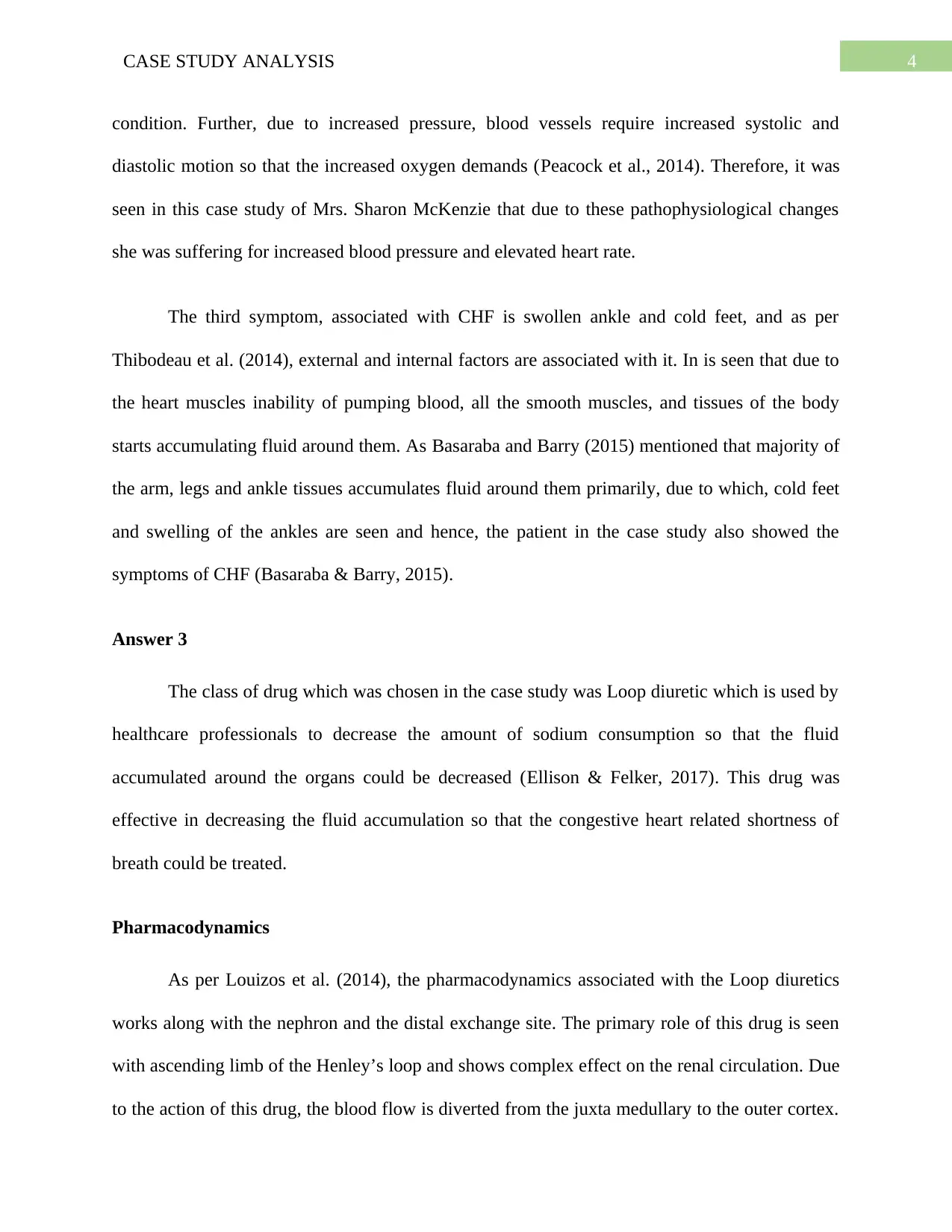
4CASE STUDY ANALYSIS
condition. Further, due to increased pressure, blood vessels require increased systolic and
diastolic motion so that the increased oxygen demands (Peacock et al., 2014). Therefore, it was
seen in this case study of Mrs. Sharon McKenzie that due to these pathophysiological changes
she was suffering for increased blood pressure and elevated heart rate.
The third symptom, associated with CHF is swollen ankle and cold feet, and as per
Thibodeau et al. (2014), external and internal factors are associated with it. In is seen that due to
the heart muscles inability of pumping blood, all the smooth muscles, and tissues of the body
starts accumulating fluid around them. As Basaraba and Barry (2015) mentioned that majority of
the arm, legs and ankle tissues accumulates fluid around them primarily, due to which, cold feet
and swelling of the ankles are seen and hence, the patient in the case study also showed the
symptoms of CHF (Basaraba & Barry, 2015).
Answer 3
The class of drug which was chosen in the case study was Loop diuretic which is used by
healthcare professionals to decrease the amount of sodium consumption so that the fluid
accumulated around the organs could be decreased (Ellison & Felker, 2017). This drug was
effective in decreasing the fluid accumulation so that the congestive heart related shortness of
breath could be treated.
Pharmacodynamics
As per Louizos et al. (2014), the pharmacodynamics associated with the Loop diuretics
works along with the nephron and the distal exchange site. The primary role of this drug is seen
with ascending limb of the Henley’s loop and shows complex effect on the renal circulation. Due
to the action of this drug, the blood flow is diverted from the juxta medullary to the outer cortex.
condition. Further, due to increased pressure, blood vessels require increased systolic and
diastolic motion so that the increased oxygen demands (Peacock et al., 2014). Therefore, it was
seen in this case study of Mrs. Sharon McKenzie that due to these pathophysiological changes
she was suffering for increased blood pressure and elevated heart rate.
The third symptom, associated with CHF is swollen ankle and cold feet, and as per
Thibodeau et al. (2014), external and internal factors are associated with it. In is seen that due to
the heart muscles inability of pumping blood, all the smooth muscles, and tissues of the body
starts accumulating fluid around them. As Basaraba and Barry (2015) mentioned that majority of
the arm, legs and ankle tissues accumulates fluid around them primarily, due to which, cold feet
and swelling of the ankles are seen and hence, the patient in the case study also showed the
symptoms of CHF (Basaraba & Barry, 2015).
Answer 3
The class of drug which was chosen in the case study was Loop diuretic which is used by
healthcare professionals to decrease the amount of sodium consumption so that the fluid
accumulated around the organs could be decreased (Ellison & Felker, 2017). This drug was
effective in decreasing the fluid accumulation so that the congestive heart related shortness of
breath could be treated.
Pharmacodynamics
As per Louizos et al. (2014), the pharmacodynamics associated with the Loop diuretics
works along with the nephron and the distal exchange site. The primary role of this drug is seen
with ascending limb of the Henley’s loop and shows complex effect on the renal circulation. Due
to the action of this drug, the blood flow is diverted from the juxta medullary to the outer cortex.
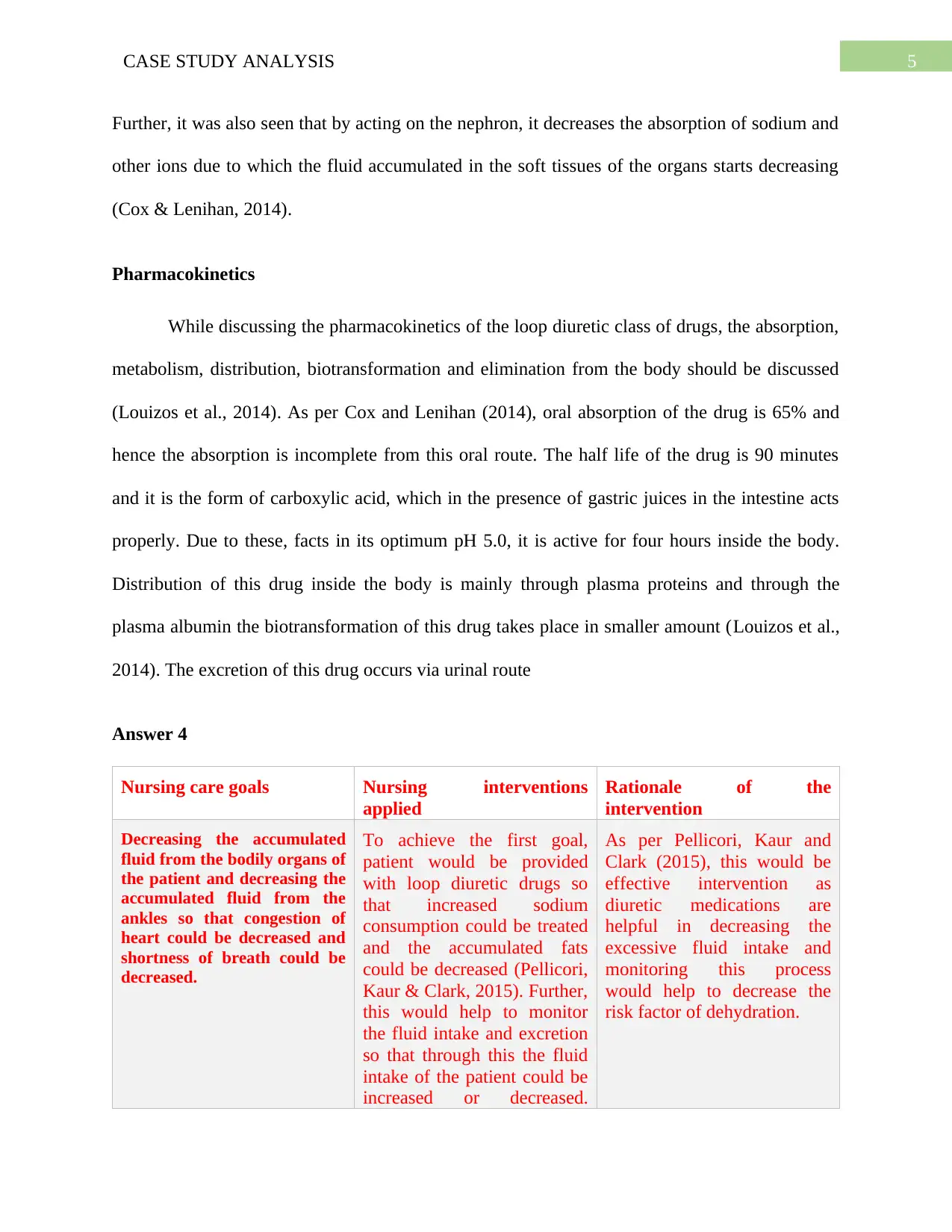
5CASE STUDY ANALYSIS
Further, it was also seen that by acting on the nephron, it decreases the absorption of sodium and
other ions due to which the fluid accumulated in the soft tissues of the organs starts decreasing
(Cox & Lenihan, 2014).
Pharmacokinetics
While discussing the pharmacokinetics of the loop diuretic class of drugs, the absorption,
metabolism, distribution, biotransformation and elimination from the body should be discussed
(Louizos et al., 2014). As per Cox and Lenihan (2014), oral absorption of the drug is 65% and
hence the absorption is incomplete from this oral route. The half life of the drug is 90 minutes
and it is the form of carboxylic acid, which in the presence of gastric juices in the intestine acts
properly. Due to these, facts in its optimum pH 5.0, it is active for four hours inside the body.
Distribution of this drug inside the body is mainly through plasma proteins and through the
plasma albumin the biotransformation of this drug takes place in smaller amount (Louizos et al.,
2014). The excretion of this drug occurs via urinal route
Answer 4
Nursing care goals Nursing interventions
applied
Rationale of the
intervention
Decreasing the accumulated
fluid from the bodily organs of
the patient and decreasing the
accumulated fluid from the
ankles so that congestion of
heart could be decreased and
shortness of breath could be
decreased.
To achieve the first goal,
patient would be provided
with loop diuretic drugs so
that increased sodium
consumption could be treated
and the accumulated fats
could be decreased (Pellicori,
Kaur & Clark, 2015). Further,
this would help to monitor
the fluid intake and excretion
so that through this the fluid
intake of the patient could be
increased or decreased.
As per Pellicori, Kaur and
Clark (2015), this would be
effective intervention as
diuretic medications are
helpful in decreasing the
excessive fluid intake and
monitoring this process
would help to decrease the
risk factor of dehydration.
Further, it was also seen that by acting on the nephron, it decreases the absorption of sodium and
other ions due to which the fluid accumulated in the soft tissues of the organs starts decreasing
(Cox & Lenihan, 2014).
Pharmacokinetics
While discussing the pharmacokinetics of the loop diuretic class of drugs, the absorption,
metabolism, distribution, biotransformation and elimination from the body should be discussed
(Louizos et al., 2014). As per Cox and Lenihan (2014), oral absorption of the drug is 65% and
hence the absorption is incomplete from this oral route. The half life of the drug is 90 minutes
and it is the form of carboxylic acid, which in the presence of gastric juices in the intestine acts
properly. Due to these, facts in its optimum pH 5.0, it is active for four hours inside the body.
Distribution of this drug inside the body is mainly through plasma proteins and through the
plasma albumin the biotransformation of this drug takes place in smaller amount (Louizos et al.,
2014). The excretion of this drug occurs via urinal route
Answer 4
Nursing care goals Nursing interventions
applied
Rationale of the
intervention
Decreasing the accumulated
fluid from the bodily organs of
the patient and decreasing the
accumulated fluid from the
ankles so that congestion of
heart could be decreased and
shortness of breath could be
decreased.
To achieve the first goal,
patient would be provided
with loop diuretic drugs so
that increased sodium
consumption could be treated
and the accumulated fats
could be decreased (Pellicori,
Kaur & Clark, 2015). Further,
this would help to monitor
the fluid intake and excretion
so that through this the fluid
intake of the patient could be
increased or decreased.
As per Pellicori, Kaur and
Clark (2015), this would be
effective intervention as
diuretic medications are
helpful in decreasing the
excessive fluid intake and
monitoring this process
would help to decrease the
risk factor of dehydration.
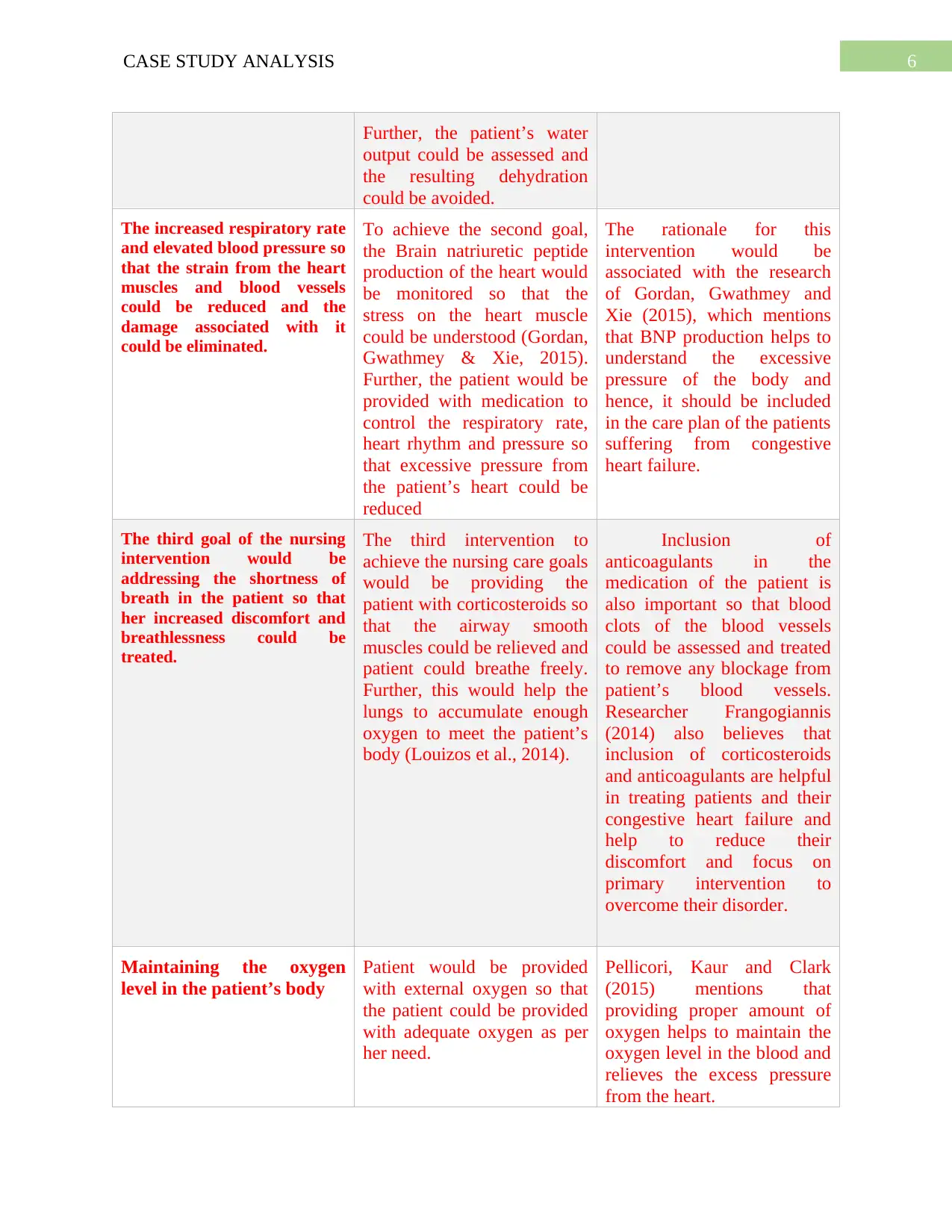
6CASE STUDY ANALYSIS
Further, the patient’s water
output could be assessed and
the resulting dehydration
could be avoided.
The increased respiratory rate
and elevated blood pressure so
that the strain from the heart
muscles and blood vessels
could be reduced and the
damage associated with it
could be eliminated.
To achieve the second goal,
the Brain natriuretic peptide
production of the heart would
be monitored so that the
stress on the heart muscle
could be understood (Gordan,
Gwathmey & Xie, 2015).
Further, the patient would be
provided with medication to
control the respiratory rate,
heart rhythm and pressure so
that excessive pressure from
the patient’s heart could be
reduced
The rationale for this
intervention would be
associated with the research
of Gordan, Gwathmey and
Xie (2015), which mentions
that BNP production helps to
understand the excessive
pressure of the body and
hence, it should be included
in the care plan of the patients
suffering from congestive
heart failure.
The third goal of the nursing
intervention would be
addressing the shortness of
breath in the patient so that
her increased discomfort and
breathlessness could be
treated.
The third intervention to
achieve the nursing care goals
would be providing the
patient with corticosteroids so
that the airway smooth
muscles could be relieved and
patient could breathe freely.
Further, this would help the
lungs to accumulate enough
oxygen to meet the patient’s
body (Louizos et al., 2014).
Inclusion of
anticoagulants in the
medication of the patient is
also important so that blood
clots of the blood vessels
could be assessed and treated
to remove any blockage from
patient’s blood vessels.
Researcher Frangogiannis
(2014) also believes that
inclusion of corticosteroids
and anticoagulants are helpful
in treating patients and their
congestive heart failure and
help to reduce their
discomfort and focus on
primary intervention to
overcome their disorder.
Maintaining the oxygen
level in the patient’s body
Patient would be provided
with external oxygen so that
the patient could be provided
with adequate oxygen as per
her need.
Pellicori, Kaur and Clark
(2015) mentions that
providing proper amount of
oxygen helps to maintain the
oxygen level in the blood and
relieves the excess pressure
from the heart.
Further, the patient’s water
output could be assessed and
the resulting dehydration
could be avoided.
The increased respiratory rate
and elevated blood pressure so
that the strain from the heart
muscles and blood vessels
could be reduced and the
damage associated with it
could be eliminated.
To achieve the second goal,
the Brain natriuretic peptide
production of the heart would
be monitored so that the
stress on the heart muscle
could be understood (Gordan,
Gwathmey & Xie, 2015).
Further, the patient would be
provided with medication to
control the respiratory rate,
heart rhythm and pressure so
that excessive pressure from
the patient’s heart could be
reduced
The rationale for this
intervention would be
associated with the research
of Gordan, Gwathmey and
Xie (2015), which mentions
that BNP production helps to
understand the excessive
pressure of the body and
hence, it should be included
in the care plan of the patients
suffering from congestive
heart failure.
The third goal of the nursing
intervention would be
addressing the shortness of
breath in the patient so that
her increased discomfort and
breathlessness could be
treated.
The third intervention to
achieve the nursing care goals
would be providing the
patient with corticosteroids so
that the airway smooth
muscles could be relieved and
patient could breathe freely.
Further, this would help the
lungs to accumulate enough
oxygen to meet the patient’s
body (Louizos et al., 2014).
Inclusion of
anticoagulants in the
medication of the patient is
also important so that blood
clots of the blood vessels
could be assessed and treated
to remove any blockage from
patient’s blood vessels.
Researcher Frangogiannis
(2014) also believes that
inclusion of corticosteroids
and anticoagulants are helpful
in treating patients and their
congestive heart failure and
help to reduce their
discomfort and focus on
primary intervention to
overcome their disorder.
Maintaining the oxygen
level in the patient’s body
Patient would be provided
with external oxygen so that
the patient could be provided
with adequate oxygen as per
her need.
Pellicori, Kaur and Clark
(2015) mentions that
providing proper amount of
oxygen helps to maintain the
oxygen level in the blood and
relieves the excess pressure
from the heart.
Paraphrase This Document
Need a fresh take? Get an instant paraphrase of this document with our AI Paraphraser

7CASE STUDY ANALYSIS

8CASE STUDY ANALYSIS
The care plan developed for Mrs. Sharon McKenzie is as follows:
The goals of the care plan would be:
Decreasing the accumulated fluid from the bodily organs of the patient and
decreasing the accumulated fluid from the ankles so that congestion of heart could
be decreased and shortness of breath could be decreased.
The increased respiratory rate and elevated blood pressure so that the strain from
the heart muscles and blood vessels could be reduced and the damage associated
with it could be eliminated.
The third goal of the nursing intervention would be addressing the shortness of
breath in the patient so that her increased discomfort and breathlessness could be
treated.
To achieve the first goal, patient would be provided with loop diuretic drugs so that
increased sodium consumption could be treated and the accumulated fats could be decreased
(Pellicori, Kaur & Clark, 2015). Further, this would help to monitor the fluid intake and
excretion so that through this the fluid intake of the patient could be increased or decreased.
Further, the patient’s water output could be assessed and the resulting dehydration could be
avoided. As per Pellicori, Kaur and Clark (2015), this would be effective intervention as diuretic
medications are helpful in decreasing the excessive fluid intake and monitoring this process
would help to decrease the risk factor of dehydration.
To achieve the second goal, the Brain natriuretic peptide production of the heart would be
monitored so that the stress on the heart muscle could be understood (Gordan, Gwathmey & Xie,
2015). Further, the patient would be provided with medication to control the respiratory rate,
The care plan developed for Mrs. Sharon McKenzie is as follows:
The goals of the care plan would be:
Decreasing the accumulated fluid from the bodily organs of the patient and
decreasing the accumulated fluid from the ankles so that congestion of heart could
be decreased and shortness of breath could be decreased.
The increased respiratory rate and elevated blood pressure so that the strain from
the heart muscles and blood vessels could be reduced and the damage associated
with it could be eliminated.
The third goal of the nursing intervention would be addressing the shortness of
breath in the patient so that her increased discomfort and breathlessness could be
treated.
To achieve the first goal, patient would be provided with loop diuretic drugs so that
increased sodium consumption could be treated and the accumulated fats could be decreased
(Pellicori, Kaur & Clark, 2015). Further, this would help to monitor the fluid intake and
excretion so that through this the fluid intake of the patient could be increased or decreased.
Further, the patient’s water output could be assessed and the resulting dehydration could be
avoided. As per Pellicori, Kaur and Clark (2015), this would be effective intervention as diuretic
medications are helpful in decreasing the excessive fluid intake and monitoring this process
would help to decrease the risk factor of dehydration.
To achieve the second goal, the Brain natriuretic peptide production of the heart would be
monitored so that the stress on the heart muscle could be understood (Gordan, Gwathmey & Xie,
2015). Further, the patient would be provided with medication to control the respiratory rate,
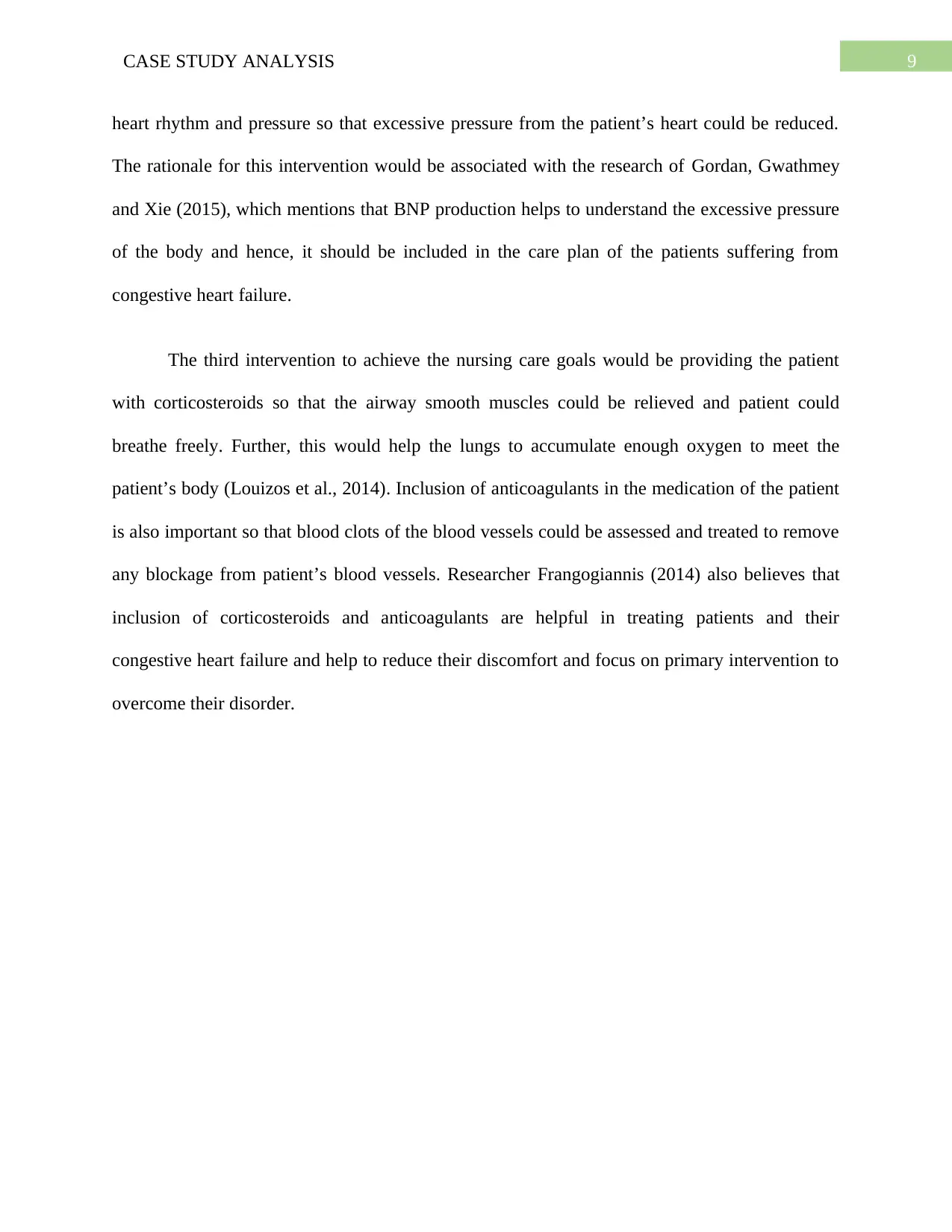
9CASE STUDY ANALYSIS
heart rhythm and pressure so that excessive pressure from the patient’s heart could be reduced.
The rationale for this intervention would be associated with the research of Gordan, Gwathmey
and Xie (2015), which mentions that BNP production helps to understand the excessive pressure
of the body and hence, it should be included in the care plan of the patients suffering from
congestive heart failure.
The third intervention to achieve the nursing care goals would be providing the patient
with corticosteroids so that the airway smooth muscles could be relieved and patient could
breathe freely. Further, this would help the lungs to accumulate enough oxygen to meet the
patient’s body (Louizos et al., 2014). Inclusion of anticoagulants in the medication of the patient
is also important so that blood clots of the blood vessels could be assessed and treated to remove
any blockage from patient’s blood vessels. Researcher Frangogiannis (2014) also believes that
inclusion of corticosteroids and anticoagulants are helpful in treating patients and their
congestive heart failure and help to reduce their discomfort and focus on primary intervention to
overcome their disorder.
heart rhythm and pressure so that excessive pressure from the patient’s heart could be reduced.
The rationale for this intervention would be associated with the research of Gordan, Gwathmey
and Xie (2015), which mentions that BNP production helps to understand the excessive pressure
of the body and hence, it should be included in the care plan of the patients suffering from
congestive heart failure.
The third intervention to achieve the nursing care goals would be providing the patient
with corticosteroids so that the airway smooth muscles could be relieved and patient could
breathe freely. Further, this would help the lungs to accumulate enough oxygen to meet the
patient’s body (Louizos et al., 2014). Inclusion of anticoagulants in the medication of the patient
is also important so that blood clots of the blood vessels could be assessed and treated to remove
any blockage from patient’s blood vessels. Researcher Frangogiannis (2014) also believes that
inclusion of corticosteroids and anticoagulants are helpful in treating patients and their
congestive heart failure and help to reduce their discomfort and focus on primary intervention to
overcome their disorder.
Secure Best Marks with AI Grader
Need help grading? Try our AI Grader for instant feedback on your assignments.
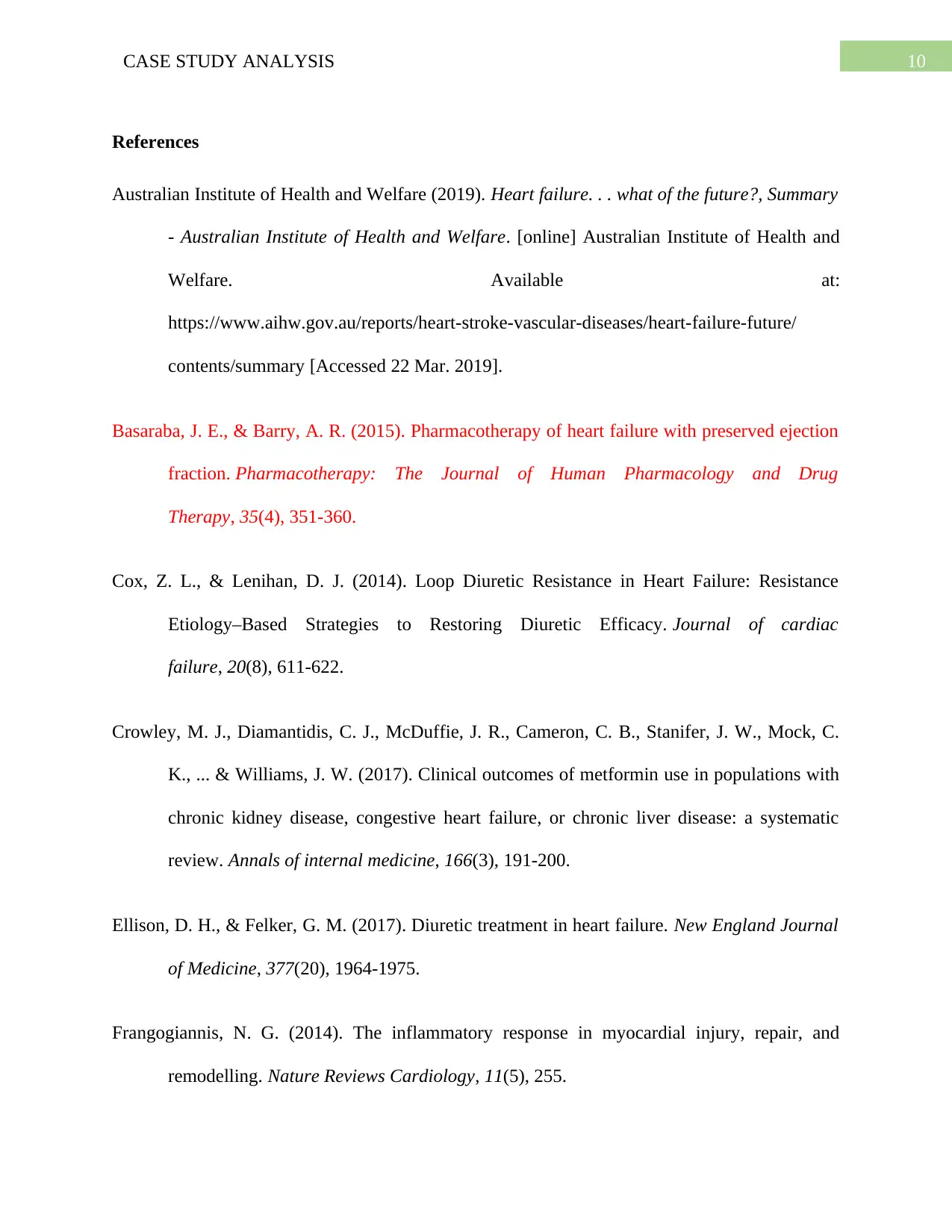
10CASE STUDY ANALYSIS
References
Australian Institute of Health and Welfare (2019). Heart failure. . . what of the future?, Summary
- Australian Institute of Health and Welfare. [online] Australian Institute of Health and
Welfare. Available at:
https://www.aihw.gov.au/reports/heart-stroke-vascular-diseases/heart-failure-future/
contents/summary [Accessed 22 Mar. 2019].
Basaraba, J. E., & Barry, A. R. (2015). Pharmacotherapy of heart failure with preserved ejection
fraction. Pharmacotherapy: The Journal of Human Pharmacology and Drug
Therapy, 35(4), 351-360.
Cox, Z. L., & Lenihan, D. J. (2014). Loop Diuretic Resistance in Heart Failure: Resistance
Etiology–Based Strategies to Restoring Diuretic Efficacy. Journal of cardiac
failure, 20(8), 611-622.
Crowley, M. J., Diamantidis, C. J., McDuffie, J. R., Cameron, C. B., Stanifer, J. W., Mock, C.
K., ... & Williams, J. W. (2017). Clinical outcomes of metformin use in populations with
chronic kidney disease, congestive heart failure, or chronic liver disease: a systematic
review. Annals of internal medicine, 166(3), 191-200.
Ellison, D. H., & Felker, G. M. (2017). Diuretic treatment in heart failure. New England Journal
of Medicine, 377(20), 1964-1975.
Frangogiannis, N. G. (2014). The inflammatory response in myocardial injury, repair, and
remodelling. Nature Reviews Cardiology, 11(5), 255.
References
Australian Institute of Health and Welfare (2019). Heart failure. . . what of the future?, Summary
- Australian Institute of Health and Welfare. [online] Australian Institute of Health and
Welfare. Available at:
https://www.aihw.gov.au/reports/heart-stroke-vascular-diseases/heart-failure-future/
contents/summary [Accessed 22 Mar. 2019].
Basaraba, J. E., & Barry, A. R. (2015). Pharmacotherapy of heart failure with preserved ejection
fraction. Pharmacotherapy: The Journal of Human Pharmacology and Drug
Therapy, 35(4), 351-360.
Cox, Z. L., & Lenihan, D. J. (2014). Loop Diuretic Resistance in Heart Failure: Resistance
Etiology–Based Strategies to Restoring Diuretic Efficacy. Journal of cardiac
failure, 20(8), 611-622.
Crowley, M. J., Diamantidis, C. J., McDuffie, J. R., Cameron, C. B., Stanifer, J. W., Mock, C.
K., ... & Williams, J. W. (2017). Clinical outcomes of metformin use in populations with
chronic kidney disease, congestive heart failure, or chronic liver disease: a systematic
review. Annals of internal medicine, 166(3), 191-200.
Ellison, D. H., & Felker, G. M. (2017). Diuretic treatment in heart failure. New England Journal
of Medicine, 377(20), 1964-1975.
Frangogiannis, N. G. (2014). The inflammatory response in myocardial injury, repair, and
remodelling. Nature Reviews Cardiology, 11(5), 255.
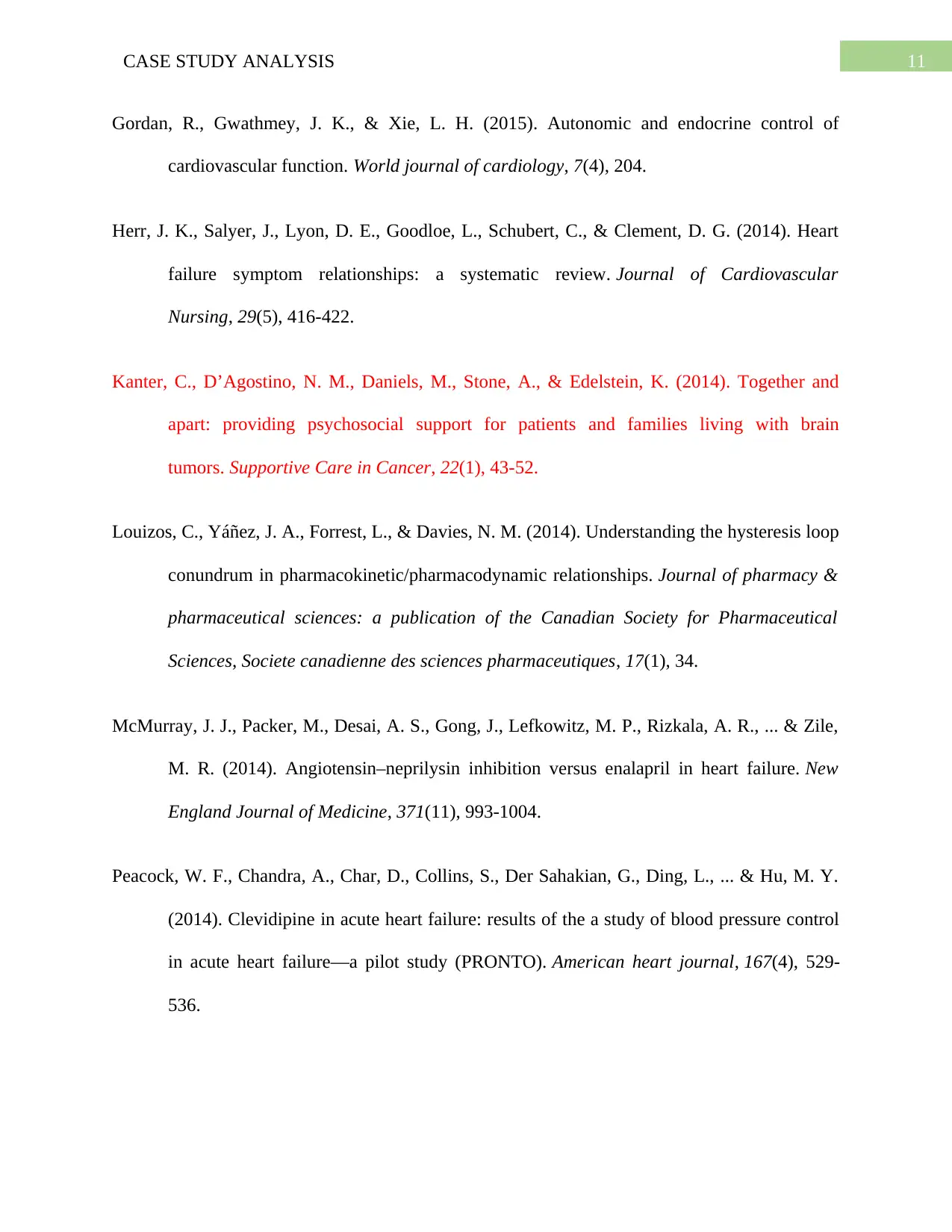
11CASE STUDY ANALYSIS
Gordan, R., Gwathmey, J. K., & Xie, L. H. (2015). Autonomic and endocrine control of
cardiovascular function. World journal of cardiology, 7(4), 204.
Herr, J. K., Salyer, J., Lyon, D. E., Goodloe, L., Schubert, C., & Clement, D. G. (2014). Heart
failure symptom relationships: a systematic review. Journal of Cardiovascular
Nursing, 29(5), 416-422.
Kanter, C., D’Agostino, N. M., Daniels, M., Stone, A., & Edelstein, K. (2014). Together and
apart: providing psychosocial support for patients and families living with brain
tumors. Supportive Care in Cancer, 22(1), 43-52.
Louizos, C., Yáñez, J. A., Forrest, L., & Davies, N. M. (2014). Understanding the hysteresis loop
conundrum in pharmacokinetic/pharmacodynamic relationships. Journal of pharmacy &
pharmaceutical sciences: a publication of the Canadian Society for Pharmaceutical
Sciences, Societe canadienne des sciences pharmaceutiques, 17(1), 34.
McMurray, J. J., Packer, M., Desai, A. S., Gong, J., Lefkowitz, M. P., Rizkala, A. R., ... & Zile,
M. R. (2014). Angiotensin–neprilysin inhibition versus enalapril in heart failure. New
England Journal of Medicine, 371(11), 993-1004.
Peacock, W. F., Chandra, A., Char, D., Collins, S., Der Sahakian, G., Ding, L., ... & Hu, M. Y.
(2014). Clevidipine in acute heart failure: results of the a study of blood pressure control
in acute heart failure—a pilot study (PRONTO). American heart journal, 167(4), 529-
536.
Gordan, R., Gwathmey, J. K., & Xie, L. H. (2015). Autonomic and endocrine control of
cardiovascular function. World journal of cardiology, 7(4), 204.
Herr, J. K., Salyer, J., Lyon, D. E., Goodloe, L., Schubert, C., & Clement, D. G. (2014). Heart
failure symptom relationships: a systematic review. Journal of Cardiovascular
Nursing, 29(5), 416-422.
Kanter, C., D’Agostino, N. M., Daniels, M., Stone, A., & Edelstein, K. (2014). Together and
apart: providing psychosocial support for patients and families living with brain
tumors. Supportive Care in Cancer, 22(1), 43-52.
Louizos, C., Yáñez, J. A., Forrest, L., & Davies, N. M. (2014). Understanding the hysteresis loop
conundrum in pharmacokinetic/pharmacodynamic relationships. Journal of pharmacy &
pharmaceutical sciences: a publication of the Canadian Society for Pharmaceutical
Sciences, Societe canadienne des sciences pharmaceutiques, 17(1), 34.
McMurray, J. J., Packer, M., Desai, A. S., Gong, J., Lefkowitz, M. P., Rizkala, A. R., ... & Zile,
M. R. (2014). Angiotensin–neprilysin inhibition versus enalapril in heart failure. New
England Journal of Medicine, 371(11), 993-1004.
Peacock, W. F., Chandra, A., Char, D., Collins, S., Der Sahakian, G., Ding, L., ... & Hu, M. Y.
(2014). Clevidipine in acute heart failure: results of the a study of blood pressure control
in acute heart failure—a pilot study (PRONTO). American heart journal, 167(4), 529-
536.
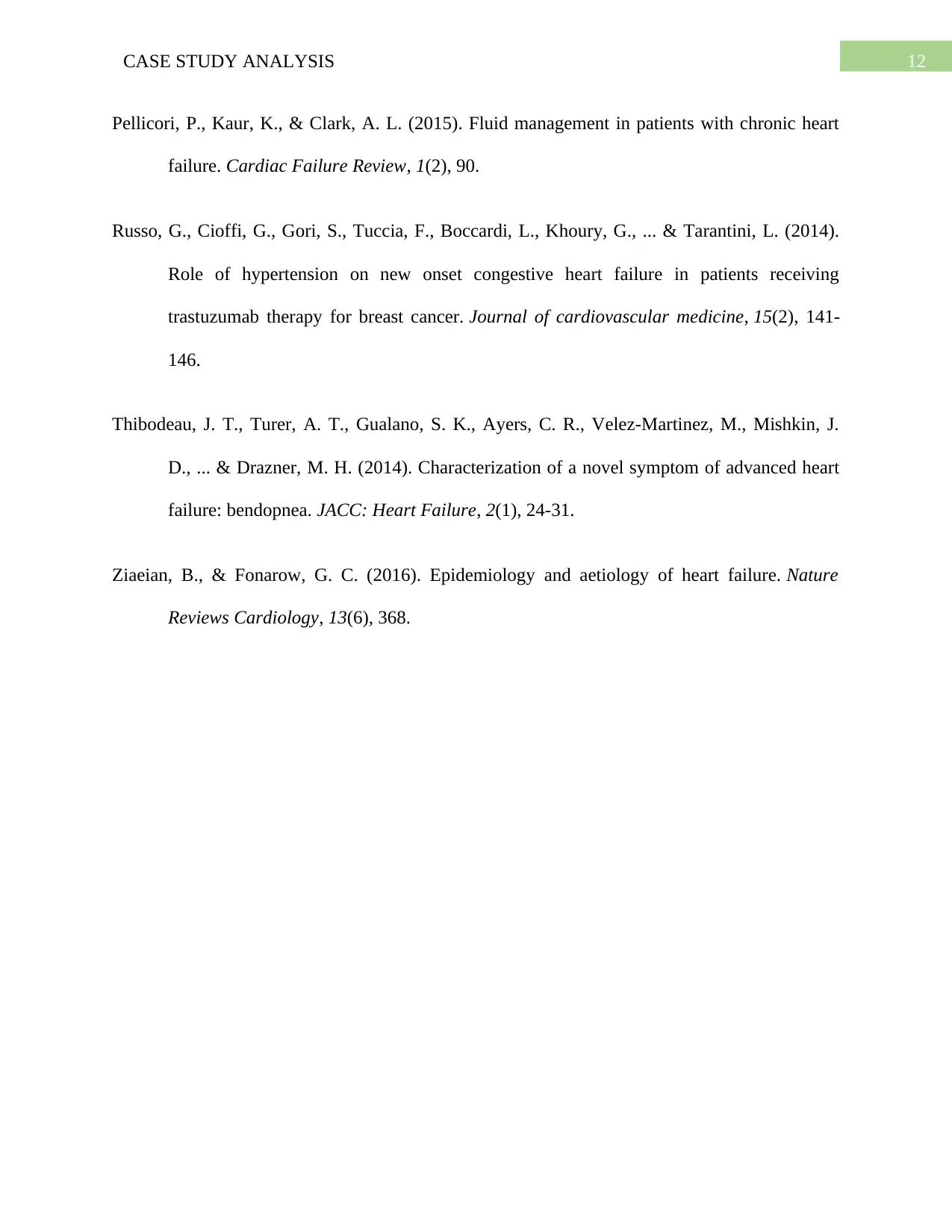
12CASE STUDY ANALYSIS
Pellicori, P., Kaur, K., & Clark, A. L. (2015). Fluid management in patients with chronic heart
failure. Cardiac Failure Review, 1(2), 90.
Russo, G., Cioffi, G., Gori, S., Tuccia, F., Boccardi, L., Khoury, G., ... & Tarantini, L. (2014).
Role of hypertension on new onset congestive heart failure in patients receiving
trastuzumab therapy for breast cancer. Journal of cardiovascular medicine, 15(2), 141-
146.
Thibodeau, J. T., Turer, A. T., Gualano, S. K., Ayers, C. R., Velez-Martinez, M., Mishkin, J.
D., ... & Drazner, M. H. (2014). Characterization of a novel symptom of advanced heart
failure: bendopnea. JACC: Heart Failure, 2(1), 24-31.
Ziaeian, B., & Fonarow, G. C. (2016). Epidemiology and aetiology of heart failure. Nature
Reviews Cardiology, 13(6), 368.
Pellicori, P., Kaur, K., & Clark, A. L. (2015). Fluid management in patients with chronic heart
failure. Cardiac Failure Review, 1(2), 90.
Russo, G., Cioffi, G., Gori, S., Tuccia, F., Boccardi, L., Khoury, G., ... & Tarantini, L. (2014).
Role of hypertension on new onset congestive heart failure in patients receiving
trastuzumab therapy for breast cancer. Journal of cardiovascular medicine, 15(2), 141-
146.
Thibodeau, J. T., Turer, A. T., Gualano, S. K., Ayers, C. R., Velez-Martinez, M., Mishkin, J.
D., ... & Drazner, M. H. (2014). Characterization of a novel symptom of advanced heart
failure: bendopnea. JACC: Heart Failure, 2(1), 24-31.
Ziaeian, B., & Fonarow, G. C. (2016). Epidemiology and aetiology of heart failure. Nature
Reviews Cardiology, 13(6), 368.
1 out of 13
Related Documents
Your All-in-One AI-Powered Toolkit for Academic Success.
+13062052269
info@desklib.com
Available 24*7 on WhatsApp / Email
![[object Object]](/_next/static/media/star-bottom.7253800d.svg)
Unlock your academic potential
© 2024 | Zucol Services PVT LTD | All rights reserved.





